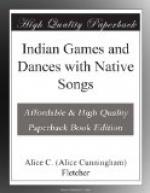INTRODUCTORY NOTE.—The objects which are thrown or tossed in games of hazard Dr. Culin for convenience has designated as “dice” and he calls the games “dice games.” (Ibid., pp. 44, 45.) He found these games among one hundred and thirty tribes belonging to thirty different linguistic stocks. Throughout this wide distribution the “dice” are not only of different forms but are made from a variety of materials: split-cane; wooden or bone staves or blocks; pottery; beaver or muskrat teeth; walnut shells; persimmon, peach or plum stones. All the “dice” of whatever kind have the two sides different in color, in marking, or in both. Those of the smaller type are tossed in a basket or bowl. Those that are like long sticks, similar to arrow shafts, from which they are primarily derived, were thrown by hand. Myths of the Pueblo tribes speak of the game, in which “dice” shaped like a shaft were used, as being played by the War Gods. The split-cane “dice” were “sacrificed” on the altar sacred to the Gods of War. In this connection it is interesting to find evidence that the “dice game” of hazard was associated with the thought of war among tribes very different, both in language and customs, from the Pueblo Indians. Among the tribes living on the prairies the word used to indicate a “point” made in a “dice game” is derived from the same root as the word used to indicate an honor won on the field of battle.
Two examples of the class of games called “dice games” are here given: the first a Pueblo game played almost exclusively by men; the second a game found among the Omaha and kindred tribes and almost exclusively played by women.
1
PA-TOL STICK GAME
Properties.—Three wooden billets; a flat stone about six inches in diameter or square; forty stones about as “big as a fist” or like pieces of wood; as many sticks for markers as there are players; counters to score the game.
Directions.—The three billets, called pa-tol sticks, are made four and a half inches long, one inch wide and half an inch in thickness; it is important that the wood from which they are made be firm and hard. Two of the billets are plain on one side, on the other side a diagonal line is incised from the left-hand upper corner to a point about two inches below the right-hand upper corner; another diagonal line is incised from the right-hand lower corner to about two inches above the left-hand lower corner. The third pa-tol stick has the same design on one side, and on the other side the design is repeated and an additional diagonal line incised from the right-hand upper corner to the left-hand lower corner. It would be well to blacken all these incised lines in order that the designs can be readily seen during the playing of the game.
[Illustration]
A circle, called the Pa-tol House, about three or four feet in diameter, is made by setting forty stones “about the size of a fist” so as to form the circumference. Between every tenth and eleventh stone there must be an opening of four or five inches. These openings must face the north, east, south and west; they are spoken of as “rivers.” The flat stone is placed in the middle of the circle.




